|
What to see
in Budapest - 25 interesting places not to be missed
|
We
are used to knowing it like Budapest, but we can also call it Pest
and Buda, or even Pest, Buda and Óbuda.
Ultimately we are always talking about the same city, united in its name by
history and by a bridge over the
Danube the
Chain Bridge. The
origin of this beautiful and interesting UNESCO World Heritage Site
is thousands of years old, and its attractions are so many and fascinating
that it takes more than a week to be visited at its best. History, culture
and architecture are unique here, nowhere else are medieval, Romanesque,
magic, Ottoman, Austrian, Jewish and Romanesque eras intertwined.
|
|
Budapest is a city of souls, the very soul of Hungary. Exploring the
historic streets, passing from one place to another in the city centre and
from one bank of the Danube to the other, it is often not possible for more
hasty tourists to see all the beauties in front of them. That is normal,
there are so many. Between parks, museums, squares, squares, palaces, spas
and wellness centres and a pulsating
nightlife,
Budapest is one of the most enjoyable and entertaining cities in Europe,
hard not to find something interesting in every corner. Due to its beauty,
ideal location and the hospitality of its inhabitants, it is often called
the "Pearl of the Danube". As monumental as few, Budapest is a city
that "gives the physical sensation of the capital, with a stateliness and
grandeur as a city that is the protagonist of history" (as Claudio Magris,
Danube, 1986) said in the words of
Vienna,
Paris,
London or
Rome.
Move around in Budapest is not a problem. The old town centre is
smaller than it seems and, ideally, to taste it better, you should walk
around it. The major tourist, landscape and cultural points of interest are
easily accessible and close to each other, but if you prefer to save some
time, using public transport becomes a simple and pleasant experience. The
Danube River divides the city into two areas: Buda and Pest. In
general the structure of the city is easy to understand. Buda's landmarks,
such as the Royal Castle, help you find your way. Besides the river
itself, it is easy to navigate through the bridges that cross it, the
Liberty Bridge (Szabadság híd), the Elisabeth Bridge (Erzsébet
híd) or the famous Chain Bridge (Széchenyi lánchíd) are just a few of
the many present. The Budapest thermal baths, which characterise the city in
a unique way, are worthy of a special mention, a legacy of Roman
colonization. The ancient Aquincum developed over time in a real'
City of Thermal Baths' in the eastern part of the empire, thermal baths
resumed during the Turkish domination and still able to cheer residents and
tourists alike.
Bud Castle
 Buda
Castle (in Hungarian, Budai Vár) from its position on the Danube
has dominated the entire city for centuries. It was the place where the city
of Budapest itself was founded, it was the historical castle used by
the Hungarian kings for their residence and today it houses the most
important medieval monuments, some of which are listed by UNESCO as a
World Heritage Site. In the past it was also called royal palace (Királyi-palota)
and royal castle (Királyi Vár). The castle dates back to the 13th century
and has been besieged no less than 31 times throughout its history...Read on
the
Castle of Buda. Buda
Castle (in Hungarian, Budai Vár) from its position on the Danube
has dominated the entire city for centuries. It was the place where the city
of Budapest itself was founded, it was the historical castle used by
the Hungarian kings for their residence and today it houses the most
important medieval monuments, some of which are listed by UNESCO as a
World Heritage Site. In the past it was also called royal palace (Királyi-palota)
and royal castle (Királyi Vár). The castle dates back to the 13th century
and has been besieged no less than 31 times throughout its history...Read on
the
Castle of Buda.
Up
The Danube
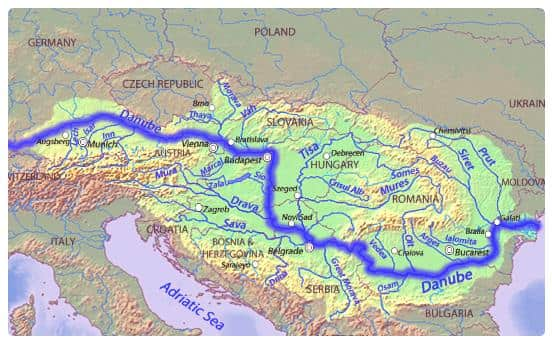 Napoleon
called the Danube "Le Roi des fleuves d' Europe". We all
learned at school during one of the geography lessons that the three most
important rivers in Europe are the Rhine, Rhone and Danube.
But the latter is not only the longest river on the continent - more than
double the length of the Rhine and almost three times the length of the
Rhone - but also flows (and forms the border) in eight countries different
from the slopes of the
Black Forest
on the shores of the Black Sea, where it flows with a large delta into
Romanian territory after a route of 2872 km.... Continue reading on the
Danube. Napoleon
called the Danube "Le Roi des fleuves d' Europe". We all
learned at school during one of the geography lessons that the three most
important rivers in Europe are the Rhine, Rhone and Danube.
But the latter is not only the longest river on the continent - more than
double the length of the Rhine and almost three times the length of the
Rhone - but also flows (and forms the border) in eight countries different
from the slopes of the
Black Forest
on the shores of the Black Sea, where it flows with a large delta into
Romanian territory after a route of 2872 km.... Continue reading on the
Danube.
Up
Budapest Parliament
 The
strongest administrative and tourist symbol of
Budapest and Hungary is the Parliament, a
large 19th century building located along the banks
of Pest on the
Danube.
The construction of the mighty structure began in
the aftermath of the Austro-Hungarian Agreement
in 1867, with the so-called Ausgleich
("compromise") between the Hungarian nobility and
the Habsburg monarchy aimed at reforming the
Austrian Empire born in 1804...Continue reading on
the
Budapest Parliament. The
strongest administrative and tourist symbol of
Budapest and Hungary is the Parliament, a
large 19th century building located along the banks
of Pest on the
Danube.
The construction of the mighty structure began in
the aftermath of the Austro-Hungarian Agreement
in 1867, with the so-called Ausgleich
("compromise") between the Hungarian nobility and
the Habsburg monarchy aimed at reforming the
Austrian Empire born in 1804...Continue reading on
the
Budapest Parliament.
Royal Palace
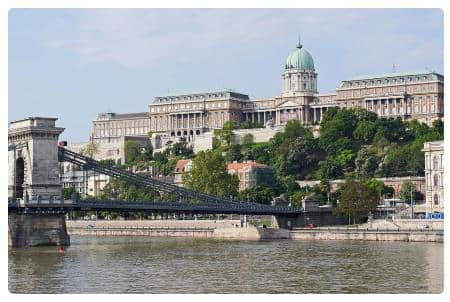 Budapest's
Royal Palace, which today houses the President of the Republic of
Hungary, was the first royal residence on Castle of Buda Hill (in Hungarian Budai Vár) built in
the 13th century after the Mongolian invasion. It was extended in the 14th
century, becoming probably the largest Gothic palace of the late Middle Ages.
The construction continued in the 15th century, after the marriage of King
Matthias Corvinus and Beatrice of Naples in 1476. Many Italian
artists and craftsmen accompanied the new queen, bringing Renaissance style
to Buda. The palace was completely destroyed when Buda was regained
to the Ottoman occupation army...Read on the
Royal Palace of Budapest. Budapest's
Royal Palace, which today houses the President of the Republic of
Hungary, was the first royal residence on Castle of Buda Hill (in Hungarian Budai Vár) built in
the 13th century after the Mongolian invasion. It was extended in the 14th
century, becoming probably the largest Gothic palace of the late Middle Ages.
The construction continued in the 15th century, after the marriage of King
Matthias Corvinus and Beatrice of Naples in 1476. Many Italian
artists and craftsmen accompanied the new queen, bringing Renaissance style
to Buda. The palace was completely destroyed when Buda was regained
to the Ottoman occupation army...Read on the
Royal Palace of Budapest.
Up
Chain Bridge
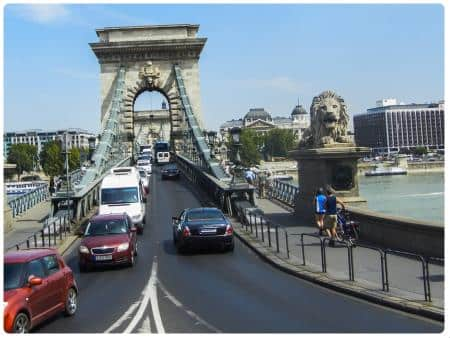 The
Chain Bridge is the oldest bridge in
Budapest,
the first bridge that has allowed to connect the two cities of Buda
and Pest. Before then they were independent of each other until 1873.
The project for its construction was entrusted to William Tierney Clark
of England and Adam Clark of Scotland (two unrelated UK engineers) on
the initiative of the Hungarian Count István Széchenyi. The engineers
chose the solution of a suspended bridge whose central span, between two
pylons, was at that time one of the largest in the world (202 m long)...Continue
reading on the
Chain Bridge. The
Chain Bridge is the oldest bridge in
Budapest,
the first bridge that has allowed to connect the two cities of Buda
and Pest. Before then they were independent of each other until 1873.
The project for its construction was entrusted to William Tierney Clark
of England and Adam Clark of Scotland (two unrelated UK engineers) on
the initiative of the Hungarian Count István Széchenyi. The engineers
chose the solution of a suspended bridge whose central span, between two
pylons, was at that time one of the largest in the world (202 m long)...Continue
reading on the
Chain Bridge.
Up
Thermal Baths
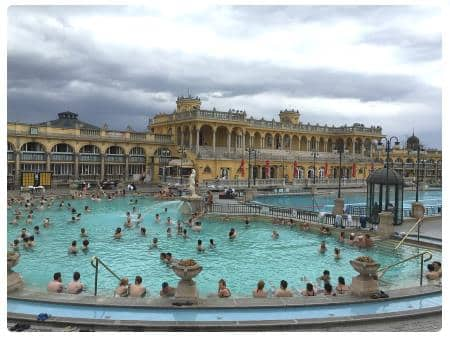 Budapest's
thermal baths have a long history that originates at the time of
Roman domination in the territory and that develops during the
Ottoman domination. Budapest is now known as the spa town par excellence,
in no other capital you can find a natural and architectural treasure of
equal historical importance. There have been 2000 years of life in
Budapest's thermal baths, at least as far as we know, despite the fact that
the springs are much older. Some of the buildings built around the springs
can still be admired and used today. Among the most popular spas in the city
are Budapest's
thermal baths have a long history that originates at the time of
Roman domination in the territory and that develops during the
Ottoman domination. Budapest is now known as the spa town par excellence,
in no other capital you can find a natural and architectural treasure of
equal historical importance. There have been 2000 years of life in
Budapest's thermal baths, at least as far as we know, despite the fact that
the springs are much older. Some of the buildings built around the springs
can still be admired and used today. Among the most popular spas in the city
are
Gellért thermal baths (Kelenhegyi ut 4, on the homonymous urban hill),
unique in style and elegance and characterized not only by an internal
architecture to leave anyone impressed for beauty and artistic sense, but
also for the beautiful outdoor swimming pool always very crowded by local
residents and tourists. They were built in Art Nouveau style between 1912
and 1918, but the origin of the springs was documented to the thirteenth
century.
Rudas thermal baths (in Rudas Gyógyfürd? és Uszoda, near the
Elisabeth bridge) are among the oldest in the city, were built in the 16th
century by the Ottomans and still retain the typical characteristic of
Turkish baths.
Thermal baths of Lukács (in Frankel Leó utca 25-29) were already
known in the 12th century by the Knights of the Order of St. John for their
healing properties, in the 19th century the first wellness centre was built,
then enlarged in the early 20th century with eight indoor and outdoor
swimming pools, surrounded by a large green area.
Szchenyi thermal baths (in ?llatkerti krt. 11) are the largest baths
of the city and among the largest in Europe. They are located within the
large city park of Városliget and were the first baths to be built in the
section of Pest. Originally, in 1881, they were called artesian baths,
changing their name to the current one in 1913.
Király thermal baths (in the F? utca 84) remain among the smallest
but most frequented in the city and among the oldest. They were built during
the Ottoman period and at that time they represented the only baths inside
the castle walls, so as to ensure their use even in times of siege.
Please note that the use of thermal baths in Hungary is an activity rooted
in the tradition and culture of the country and each bath has its own set of
rules to comply with, which can change without notice. For further
information see the dedicated article:
Budapest's thermal baths
Up
Budapest Opera House
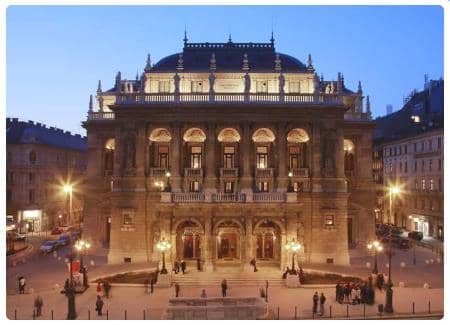 This
historic Opera building is located halfway along the tree-lined
Andrássy Út Avenue.
Budapest's work is one of the most beautiful neo-Renaissance buildings in
Europe. When it was inaugurated in 1884, the city shared the administrative
duties of the Austro-Hungarian Empire with Vienna. In fact, it was Emperor
Franz Joseph who commissioned the project. The building included the use of
marble and frescoes by some of the best craftsmen of that time... Read on
the
Budapest Opera House. This
historic Opera building is located halfway along the tree-lined
Andrássy Út Avenue.
Budapest's work is one of the most beautiful neo-Renaissance buildings in
Europe. When it was inaugurated in 1884, the city shared the administrative
duties of the Austro-Hungarian Empire with Vienna. In fact, it was Emperor
Franz Joseph who commissioned the project. The building included the use of
marble and frescoes by some of the best craftsmen of that time... Read on
the
Budapest Opera House.
Up
West Station of Budapest
(Nyugati Pályaudvar)
Teréz Körút at Nyugati térati tér
Area: Historic centre / Pest
Metro: Nyugati pu. (M3)
 The
large building that saw the first train set off in Hungary, 1846 (then
called Vác station), is admired for its Art Nouveau style in glass and iron,
built in the second half of the 19th century by the same people who built
the
Eiffel Tower in
Paris. At the time of its completion it was considered to be one of the
largest stations in the world. Note that the McDonald's of the
station is considered the most beautiful of the whole planet (you'll see
from you). The
large building that saw the first train set off in Hungary, 1846 (then
called Vác station), is admired for its Art Nouveau style in glass and iron,
built in the second half of the 19th century by the same people who built
the
Eiffel Tower in
Paris. At the time of its completion it was considered to be one of the
largest stations in the world. Note that the McDonald's of the
station is considered the most beautiful of the whole planet (you'll see
from you).
Up
East Budapest Station
(Keleti Pályaudvar)
Baross tér
Area: Pest
Metro: Keleti pu. (M2, M4)
 Located
at Barros Square, the eastern station of Budapest is also known as
Keleti Station and was built between 1881 and 1884 according to a design
by architects Gyula Rochlitz and János Feketeházy. The style
is eclectic and elegant, with neo-Renaissance influences. You can admire in
particular the central hall and the wall paintings inside the station, by
Hungarian artists Károly Lotz and Mór Than. There are three
international train stations in Budapest (the one above and the Pályaudvar
Deli), this one in Keleti is the largest and most important. Located
at Barros Square, the eastern station of Budapest is also known as
Keleti Station and was built between 1881 and 1884 according to a design
by architects Gyula Rochlitz and János Feketeházy. The style
is eclectic and elegant, with neo-Renaissance influences. You can admire in
particular the central hall and the wall paintings inside the station, by
Hungarian artists Károly Lotz and Mór Than. There are three
international train stations in Budapest (the one above and the Pályaudvar
Deli), this one in Keleti is the largest and most important.
Budapest
Zoo
 In
front of the spa complex of Széchényi, a secessionist stone portal
decorated with statues of elephants marks the entrance to the Zoo and
Botanical Garden of Budapest (Fővárosi ?llat- és Nővénykert), opened in
1865 with 500 animals, is one of the oldest zoo in Europe. After years of
relative abandonment, it has now been put back on a high gloss. In addition
to the hundreds of plant species, it has buildings of great architectural
interest. Compared to other European zoos, it is very expensive and can be a
great experience for young and old alike or for the whole family...Read on
the
Budapest Zoo. In
front of the spa complex of Széchényi, a secessionist stone portal
decorated with statues of elephants marks the entrance to the Zoo and
Botanical Garden of Budapest (Fővárosi ?llat- és Nővénykert), opened in
1865 with 500 animals, is one of the oldest zoo in Europe. After years of
relative abandonment, it has now been put back on a high gloss. In addition
to the hundreds of plant species, it has buildings of great architectural
interest. Compared to other European zoos, it is very expensive and can be a
great experience for young and old alike or for the whole family...Read on
the
Budapest Zoo.
Up
Memento Park
 The
Memento Park (in Hungarian Szoborpark) is an open-air museum in
Budapest, dedicated to monumental statues and sculpted plaques from the
communist period of Hungary (1949-1989). Here you will find statues of some
of the most important symbols of communism such as Lenin, Marx and Engels,
as well as some Hungarian Communist leaders. The park was designed by the
Hungarian architect ?kos Ele?d, who won the competition announced by the
Budapest General Assembly in 1991 (F?városi Közgy?lés). On the maps of
public transport the park is generally shown as a memorial. Read more on
Memento Park in Budapest. The
Memento Park (in Hungarian Szoborpark) is an open-air museum in
Budapest, dedicated to monumental statues and sculpted plaques from the
communist period of Hungary (1949-1989). Here you will find statues of some
of the most important symbols of communism such as Lenin, Marx and Engels,
as well as some Hungarian Communist leaders. The park was designed by the
Hungarian architect ?kos Ele?d, who won the competition announced by the
Budapest General Assembly in 1991 (F?városi Közgy?lés). On the maps of
public transport the park is generally shown as a memorial. Read more on
Memento Park in Budapest.
Up
Budapest Islands
 Along
the Danube that crosses Budapest there are seven islands, the most famous of
which are: the island of Margherita, 2.5 km long and characterized by a
beautiful park very popular for recreational areas; the island Csepel,
the largest of the river and the country and located south of the city, over 48
km long and with some of the peripheral municipalities in Budapest. Along
the Danube that crosses Budapest there are seven islands, the most famous of
which are: the island of Margherita, 2.5 km long and characterized by a
beautiful park very popular for recreational areas; the island Csepel,
the largest of the river and the country and located south of the city, over 48
km long and with some of the peripheral municipalities in Budapest.
Up
Ostelli Budapest
Ostelli
Ungheria
Hotel a Budapest
Hotel in Ungheria
Carte de Budapest Karte von Budapest Mapa Budapest Map of Budapest
Carte de Hongrie Karte von Urgan
Mapa Hungría Map of Hungary
|
